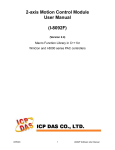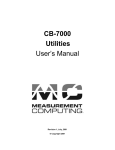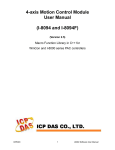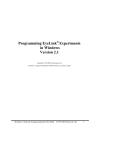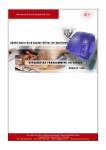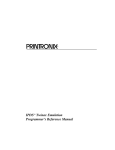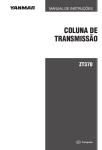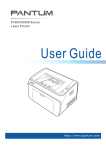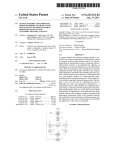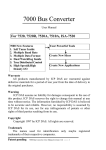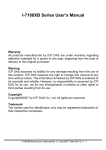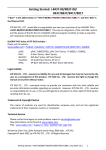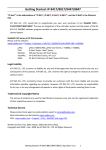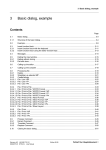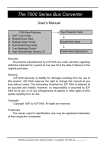Download DCON Utility (DOS)
Transcript
DCON Utility (DOS)
User Manual
7000 New Features
1. Self Tuner Inside
2. Multiple Baud Rate
3. Multiple Data Format
4. Dual WatchDog Inside
5. True Distributed Control
6. High Speed&High Density
I/O
Your Powerful Tools
Create New Ideas
Create New Applications
Warranty
All products manufactured by ICP DAS are warranted
against defective materials for a period of one year from the
date of delivery to the original purchaser.
Warning
ICP DAS assume no liability for damages consequent to
the use of this product. ICP DAS reserves the right to change
this manual at any time without notice. The information
furnished by ICP DAS is believed to be accurate and reliable.
However, no responsibility is assumed by ICP DAS for its use,
nor for any infringements of patents or other rights of third
parties resulting from its use.
Copyright
Copyright 1997 by ICP DAS. All rights are reserved.
Trademark
The names used for identification only maybe registered
trademarks of their respective companies.
License
The user can use, modify and backup this software on a
single machine. The user may not reproduce, transfer or
distribute this software, or any copy, in whole or in part.
DCON Utility (DOS) User’s Manual, Mar/2003, Ver. 1.0.1------------ 1
Table of Contents
1. Introduction............................................................................................3
1.1 Floppy Contents ............................................................................3
1.2 Compiler & Link Using TC ..........................................................3
1.3 Q&A..............................................................................................4
2. Diagnostic Program ...............................................................................8
2.1 Functions Description ...................................................................8
2.2 DIAG TC Source Program..........................................................18
2.3 DIAG QB Source Program .........................................................40
3. Learning Kits Software........................................................................41
3.1 Driver Source ..............................................................................42
3.2 Function Descriptions .................................................................43
3.3 Demo of the Digital Control learning Kit...................................46
3.4 Demo of the Analog learning Kit ...............................................46
3.5 Demo of the RS-485 Network learning Kit ................................46
3.6 Demo of the high speed high number Digital Control Kit .........47
3.7 Demo of the high speed high number data acquisition Kit ........47
3.8 Demo of the the professional kit.................................................47
4. PC Networking Applications ...............................................................48
5. PLC Networking Applications ............................................................54
5.1 Introduction.................................................................................54
5.2 Example ......................................................................................56
6. MMICON Applications ......................................................................60
6.1 Introduction.................................................................................60
7. 5860 Applications ................................................................................63
7.1 5860/5/7/12 Specifications .........................................................63
7.2 5860 features ...............................................................................64
7.3 5860 Software Environment .......................................................64
DCON Utility (DOS) User’s Manual, Mar/2003, Ver. 1.0.1------------ 2
1
Introduction
The DCON Utility (DOS) provides utility, demo programs
and data acquisition subroutines for the user to handle
7000/8000/87000 series modules. The 7000/8000/87000 are a
family of remote controllable data acquisition modules. They
provide A/D, D/A, DI/O, Timer/Counter, MMI and other
functions. The 7000 modules operate with a simple command /
response protocol to control all module functions.
1.1
Directory Contents
The contents of the directory is given as following:
\README.txt
read me file
\DCON_Utility_DOS\DIAG\*.*
diagnostic utility
\DCON_Utility_DOS \learning\*.*
learning kits utility
\DCON_Utility_DOS \PC_NET\*.*
PC-networking application utility
\DCON_Utility_DOS \PLC_NET\*.*
7000 PLC-networking application utility
1.2
Compiler & Link Using TC
The including file
UART.H
There are 2 source files
UART.C & TEST.C
The project file
TEST.PRJ
Use TC integrated environment to select large model &
project file
press F9 to compiler & link
DCON Utility (DOS) User’s Manual, Mar/2003, Ver. 1.0.1------------ 3
1.3
Q&A
(Q1) How to program the 7000/8000/87000 modules ?
(A1) The user can use any RS-232C device to send the command
string to the 7000/8000/87000 modules and the 7000/8000/87000
modules will echo the result string to the RS-232C device. The data
format of command character is given as following :
Data format=1_start+8_data+no_parity+1_stop
total=1+8+1=10 bits per character
The user shouldn’t change this format to the following
invalidate format:
1_start+8_data+no_parity+2_stop
invalidate format
1_start+8_data+even_parity+1_stop
invalidate format
1_start+8_data+odd_parity+1_stop
invalidate format
1_start+7_data+no_parity+2_stop
invalidate format
1_start+7_data+even_parity+1_stop
invalidate format
1_start+7_data+odd_parity+1_stop
invalidate format
(Q2) What programming language can be used ?
(A2) Any programming language can be used to program the
7000/8000/87000 modules, if this language can send out the RS-232C
command string. It is recommended to use the C/C++ , VB, and
Delphi.
DCON Utility (DOS) User’s Manual, Mar/2003, Ver. 1.0.1------------ 4
(Q3) Can the baud rate be changed?
(A3) Yes, the validate baud rate are 1200, 2400, 4800, 9600, 19200,
38400, 57600 and 115200 BPS. PC can send out the command string
under all these baud rate. Refer to Sec. 2.1.1 for baud rate change.
(Q4) Can the checksum of the command string be enabled?
(A4) Yes, but the default condition of checksum is DISABLE. Refer
to Sec. 2.1.1 for enable/disable checksum. To ENABLE the checksum,
two more checksum char must be added to the original command
string. So the command string in checksum enable mode is two more
bytes longer than the default checksum disable command string.
$012[0x0D]
$012B1[0x0D]
command string under checksum DISABLE
command string under checksum ENABLE
(Q5) How to calculate the checksum ?
(A5) The steps to calculate the checksum are given as following:
1. step 1: checksum=0
2. step 2: for all command byte checksum = checksum +
command byte
3. step 3: checksum=checksum&0xff
4. step 4 : convert checksum to ASCII high byte and ASCII
low byte
for example,
command = $012[Enter]
checksum = $+0+1+2 = 0x24+0x30+0x31+0x32
= 0xB7
checksum & 0xff = 0xB7
checksum ASCII high byte = ASCII B = 0x42
checksum ASCII low byte = ASCII 7 = 0x37
command with checksum = $012B7[Enter]
DCON Utility (DOS) User’s Manual, Mar/2003, Ver. 1.0.1------------ 5
(Q6) What’s the syntax of the command string ?
(A6) The syntax of command string is shown as following:
[leading char][address][data][checksum][0x0D]
[leading char] = $ or % or # or @ or ~
[address] = 00 to FF
256 different module address max.
[data]
= command code and the related data if needed
[checksum]= two chars if checksum enable
= no char if checksum disable
[0x0D]
= ASCII code 0x0d, the command string terminator
Command string
Result string
$ 0 1 2 0x0D
!
0 1 0 5 0 6 0 0 0x0D
(Q7) Can I use the 7000/8000/87000 module in the RS-232C
network ?
(A7) No, the 7000/8000/87000 use the RS-485 network. So the users
need a 7520, RS-232 to RS-485 converter, to convert the RS-232C
signal to the RS-485 signal. That is to say that the users need at least
two modules to form a minimum 7000/8000/87000 system. One is the
7520 and another is 7000/8000/87000 module (A/D or D/A or DI/O or
Timer/Counter modules).
(Q8) Can the 7000/8000/87000 be used as a full duplex RS485 system ?
(A8) NO, the 7000/8000/87000 is worked in a half duplex RS-485
system. The 7000/8000/87000 use a two-wire, D+ and D-, differential
RS-485 network. The D+ and D- signal logically form a single bidirection data line, so this single data line can send or receive data in
the different time. Therefore the 7000/8000/87000 can't send the
command string and receive the result string at the same time. The
host computer must send the command string first then wait for the
result string returned by the 7000/8000/87000.
DCON Utility (DOS) User’s Manual, Mar/2003, Ver. 1.0.1------------ 6
(Q9)
Who handle the direction of two-wire RS-485 network ?
(A9) The two-wire RS-485 network is a pairs of differential signal. So
logically these two line equals to one data line. This data line can be
used to transfer command and receive result both. This needs a
direction controller to handle the two-wire RS-485 network. The 7520,
RS-232 to RS-485 converter, is a intelligent controller. It will
automatically detect and control the direction of data flow. When the
host computer send RS-232C command string, the 7520 set the
direction of the RS-485 network in received mode and the
7000/8000/87000 modules can receive the host’s command string.
After the command string is finished, the 7520 will set the RS-485
network in send mode to allow the 7000/8000/87000 modules to send
the result to the host computer. Everything is automatically done, the
user need not to care about the direction of data flow. The user only
has to care that he should send the command string first then waiting
for the result string next. The RTS-control signal of RS-232 is ignored.
The 7000/8000/87000 don’t use the RTS signal.
(Q10) Can I use the 7000/8000/87000 in the conventional 4wire RS-485 network ?
(A10) No. The 7000/8000/87000 is designed for 2-wire RS-485
network
(Q11) How can the 7000/8000/87000 modules identify the
correct command ?
(A11) Every 7000/8000/87000 module has it’s own module address.
The command string always include the desired module’s address.
When the host computer send the command string, all the 7000
modules in the RS-485 network will receive this command string at
the same time. Then All the 7000/8000/87000 modules will interpret
this command string simultaneously. They will fetch the address field
and identify the destination address. Only the module with the same
address as the destination address will response to the host computer.
All the other module in the network will bypass this command string
and waiting for the next command.
For example, $012[0x0D] is a validate command string and the
destination address is 01. The 7000/8000/87000 module with address
01 will response to this command.
DCON Utility (DOS) User’s Manual, Mar/2003, Ver. 1.0.1------------ 7
2
2.1
Diagnostic Program
Functions Description
The
diagnostic
program
\DCON_Utility_DOS\DIAG\TC\TEST.EXE can be executed in
the environment of DOS, Windows 3.1, Windows 95, Windows
NT. Run TEST.EXE, the screen will be shown as following:
There are six functions supported in TEST.EXE given as
following:
0 : init. to initialize the COM port
1 : search to search the 7000/8000/87000 modules in the
RS-485 network
2 : send command to send command string and receive
the result string
3 : demo to demo command “$012”,”$01M”,”$01F”
4 : Host Watchdog Test test programmable host
watchdog
5 : RS-485 network testing test the stability of RS-485
network
Q: quit to quit the TEST.EXE
DCON Utility (DOS) User’s Manual, Mar/2003, Ver. 1.0.1------------ 8
2.1.1
Init Function
The operation steps to initialize the COM port are given as
following :
1. step 1 : press 0
2. step 2 : press 1[Enter]
3. step 3 : press 9600[Enter]
4. step 4 : press 0[Enter]
step 1 : select functoion_0 of TEST.EXE
step 2 : key in COM port code, 1 COM1, 2 COM 2,
3 COM3, 4 COM4
step 3 : key in baud rate, 1200 or 2400 or 4800 or 9600 or
19200 or 38400 or 57600 or 115200
step 4 : key in checksum ENABLE/DISABLE, (0 is
DISABLE, others=ENABLE)
This function will initialize the COM-port of PC. The
function_2/3/4 will also use this setting later. The default setting
is COM1, 9600 and checksum DISABLE. This configuration is
suitable for 7000/8000/87000 default setting. If the
7000/8000/87000 modules are used in another configuration,
the user has to use this function to re-initialize the PC COM port.
DCON Utility (DOS) User’s Manual, Mar/2003, Ver. 1.0.1------------ 9
2.1.2
Search Function
The operation steps of search function all the
7000/8000/87000 modules connected in the RS-485 network
are given as following:
step 1 : press 1
step 2 : wait until no need to search, press any key
This function will search from baud rate 1200 to 115200 for
address 00. Then search from baud rate 1200 to 115200 for address
01, …… At last search form baud rate 1200 to 115200 for address
0xFF. If the user press any key during the search interval, this
function will stop immediately. If any 7000/8000/87000 module is
found, the module name, address, checksum status and baud rate
will be shown in the screen. In this example, the search function find
six 7000/8000/87000 module in the RS-485 network. Their module
addresses are all equal to 01 but their baud rate are all different.
The 7000/8000/87000 series modules can share the same RS-485
network with different baud rate. Therefor there can be installed
256*8=2048 modules with repeater in one RS-485 network. This
function will search all possible modules including checksum
enable/disable in the RS-485 network, therefore this function will
search 2048*2=4096 times max. in one completely search interval as
following:
DCON Utility (DOS) User’s Manual, Mar/2003, Ver. 1.0.1------------ 10
1. step 1 : baud rate=1200, send $002[Enter]
2. step 2 : baud rate=1200, send $002B6[Enter]
3. step 3 : baud rate=2400, send $002[Enter]
wait for response
wait for response
wait for response
4. step 4 : baud rate=2400, send $002B6[Enter] wait for response
5. …………………………………………………………………………..
6. step 15 : baud rate=115200, send $002[Enter]
wait for response
7. step 16 : baud rate=115200, send $002B6[Enter]
8. step 17 : baud rate=1200, send $012[Enter]
for address
00
wait for response
wait for response
9. step 18 : baud rate=1200, send $012B7[Enter]
wait for response
10.…………………………………………………………………………..
11.…………………………………………………………………………..
12. step 31 : baud rate=115200, send $012[Enter]
wait for response
13. step 32 : baud rate=115200, send $012B7[Enter] wait for response
14.…………………………………………………………………………..
15.…………………………………………………………………………..
16. step 4095 : baud rate=115200, send $FF2[Enter ]
17. step 4096 : baud rate=115200, send $FF2E2[Enter]
DCON Utility (DOS) User’s Manual, Mar/2003, Ver. 1.0.1------------ 11
for address
01
for address
FF
2.1.3
Send Command Function
The operation steps of send command function are given as
following:
1. step 1 : press 2
2. step 2 : press ??…??[Enter]
The operation steps of this function are given as following:
Step 1: This function will automatically add the [0x0D] to the input
string.
Step 2 : If the checksum status is ENABLE, the extra two checksum
bytes will be added into the input string also.
Step 3: This function will send out the command string first then wait
for the result string.
Step 4: If the result string is received before the time-out interval, this
function will automatically check the format of the result
string. The result string will be shown on the screen.
Step 5: If no module response to this command, the time-out message
will be shown on the screen.
DCON Utility (DOS) User’s Manual, Mar/2003, Ver. 1.0.1------------ 12
2.1.4
Demo Function
$012[0x0D] : read module configuration code
$01M[0x0D] : read module name
$01F[0x0D] : read firmware version number
This function will send out these three commands in sequence
to identify the module’s basic information. This function is
very useful during the diagnostic interval.
The operation step of demo function is given as following:
step 1 : press 3
-
DCON Utility (DOS) User’s Manual, Mar/2003, Ver. 1.0.1------------ 13
2.1.5
Test Host WatchDog Function
The operation steps to test programmable host watchdog are
shown as following:
1. step 1 : press 4
2. step 2 : press any key to simulate host failure
3. step 3 : press any key to clear module status
DCON Utility (DOS) User’s Manual, Mar/2003, Ver. 1.0.1------------ 14
This function gives a short demo about the programmable
host watchdog. The operation steps are given as following:
step 1: send command to control D/A of 7021 to
5V(address=03).
step 2: enable the host watchdog(host watchdog timer =1
second)
step 3: send ~**[0x0D] command to refresh the host
watchdog timer
step 4: user press any key to stop the refresh operation
simulate host failure
step 5: after 1 second, the host watchdog timer will be active
the DA output will go to the safe value
the module-LED will flash
the module status will be setting to 04
disable the host watchdog timer automatically.
will ignore any D/A output command from host
step 6 : user press any key to clear the module status
the module status is clear to 0
the module-led will no more flash
the DA output unchanged
will accept and execute host D/A output command
DCON Utility (DOS) User’s Manual, Mar/2003, Ver. 1.0.1------------ 15
2.1.6
Test RS-485 Network Function
The operation steps to test RS-485 network are shown as
following:
1. step 1 : install all modules into RS-485 network
2. step 2 : edit TEST.DAT
3 step 3 : press 5 to select “RS-485 network testing” function
This function will read the command and expected
response from TEST.DAT first, then send out the command
and check the module response. If the module response and
expected response is the same
OK=OK+1. If they are
different
ERR=ERR+1. This function will repeat testing
until the user press any key to stop
DCON Utility (DOS) User’s Manual, Mar/2003, Ver. 1.0.1------------ 16
The format of TEST.DAT is given as following:
line 1 : N number of commands to test
line 2 : command_1
line 3 : command_2
…………………..
line N+1 : command_N
The format of command is given as following:
com port Baud rate
1/2/3/4
checksum Comman expected
d
response
1200/2400/4800/9600/ 0 : disable 7000
expected
19200/38400/57600/ 1 : enable command response from
115200
7xxx
The default TEST.DAT is given as following :
6
1 4800 0 $012 !01400502
1 9600 0 $012 !01400600
1 19200 0 $012 !01080700
1 38400 0 $012 !01400800
1 57600 0 $012 !01080900
DCON Utility (DOS) User’s Manual, Mar/2003, Ver. 1.0.1------------ 17
2.2
DIAG TC Source Program
The usage of TEST.EXE are given in Sec. 2.1. The
complete source codes are given in the companion floppy disk.
These programs are written in TURBO-C.
The files in \DCON_Utility_DOS\DIAG\TC are given as
below:
1.
2.
3.
4.
UART.H
UART.C
TEST.C
TEST.PRJ
header file
library file
application file
project file
The compiler and link for TC are given as below:
1. Set DOS PATH to TC
2. Using TC integrated environment to set PROJECT to
TEST.PRJ
3. Press F9 to MAKE the project file (TEST.PRJ)
4. Execution file = TEST.EXE
2.2.1
TEST.PRJ
UART.C
TEST.C
2.2.2
6
1
1
1
1
1
1
TEST.DAT
4800 0 $012 !01400502
9600 0 $012 !01400600
19200 0 $012 !01080700
38400 0 $012 !01400800
57600 0 $012 !01080900
115200 0 $012 !01230A00
DCON Utility (DOS) User’s Manual, Mar/2003, Ver. 1.0.1------------ 18
2.2.3
#include
#include
#include
#include
#include
#include
#include
#include
UART.H
<stdio.h>
<stdlib.h>
<math.h>
<conio.h>
<io.h>
<dos.h>
<stdarg.h>
<string.h>
#define Com1
#define Com2
#define Com3
#define Com4
0x3f0
0x2f0
0x3e0
0x2e0
#define Txbuf 0x08
#define Rxbuf 0x08
#define Dll
0x08
#define Dlh
0x09
#define Ier 0x09
#define Fcr
0x0a
#define Lcr
0x0b
#define Dfr
0x0b
#define Mcr
0x0c
#define Lsr
0x0d
/* tx buffer */
/* rx buffer */
/* baud lsb */
/* baud msb */
/* int enable reg */
/* FIFO control register */
/* line control reg */
/* Data format reg */
/* modem control reg */
/* line status reg */
int OPEN_COM(int iPort, long int lBaudRate);
int CLOSE_COM(int iPort);
int SEND_CMD(int iPort, char cCmd[], long int lTimeout, int
iChksum);
int RECEIVE_CMD(int iPort, char cCmd[], long int lTimeout,
int iChksum);
DCON Utility (DOS) User’s Manual, Mar/2003, Ver. 1.0.1------------ 19
2.2.4
UART.C
#include "uart.h"
int iBase;
/* com port base address */
char cHI,cLO;
void compute_chksum(char cBuf[]);
char hex_to_ascii(int iHex);
/* ----------------------------------------------------------------------- */
/* input: port = 1/2/3/4
baud = 1200/2400/4800/9600/19.2K/38.4K/57.6K/115.2K
chksum = 0 is DISABLE, others is ENABLE
return : 0
1
2
*/
OK
port value error
baud rate error
int OPEN_COM(int iPort, long int lBaudRate)
{
int uart,i;
char ratehi,ratelo;
long int bb;
int cc;
switch(iPort)
{
case 1 : iBase=Com1; break;
case 2 : iBase=Com2; break;
case 3 : iBase=Com3; break;
case 4 : iBase=Com4; break;
default: printf("(iPort=%d)",iPort); getch();
return 1;
/* port must 1/2/3/4 */
}
DCON Utility (DOS) User’s Manual, Mar/2003, Ver. 1.0.1------------ 20
switch(lBaudRate)
{
case 1200L : break;
case 2400L : break;
case 4800L : break;
case 9600L : break;
case 19200L: break;
case 38400L: break;
case 57600L: break;
case 115200L: break;
default : return 2;
/* baud rate error */
}
bb=115200L;
cc=bb/lBaudRate;
ratehi=(cc&0xff00)>>8;
ratelo=cc&0xff;
outportb(iBase+Lcr,0x80); /* set DLAB */
outportb(iBase+Dll,ratelo);
outportb(iBase+Dlh,ratehi);
outportb(iBase+Lcr,0x03); /* data format */
/* 0000 0011 --> 8_bit+1_stop+no_parity */
outportb(iBase+Ier,0);
/* disable interrupt */
outportb(iBase+Fcr,0x07); /* clear input/output FIFO*/
for (i=0; i<8; i++) inportb(iBase+i); /* clear R */
outportb(iBase+Fcr,0x01); /* enable FIFO */
return 0;
}
/* ----------------------------------------------------------------------- */
/* return : 0 --> OK
1 --> error
*/
int CLOSE_COM(int iPort)
{
/* use polling, so do nothing here */
return 0;
}
DCON Utility (DOS) User’s Manual, Mar/2003, Ver. 1.0.1------------ 21
/* ----------------------------------------------------------------------- */
/* return : 0 --> OK
1 --> port value error
2 --> timeout
*/
int SEND_CMD(int iPort, char cCmd[], long int lTimeout, int
iChksum)
{
int i,ret;
long t;
switch(iPort)
{
case 1 : iBase=Com1; break;
case 2 : iBase=Com2; break;
case 3 : iBase=Com3; break;
case 4 : iBase=Com4; break;
default: return 1;
/* port must 1/2/3/4 */
}
compute_chksum(cCmd);/* add chksum and 0x0d to input */
i=0; t=0;
while (cCmd[i]!=NULL)
{
while((inportb(iBase+Lsr)&0x20)==0) /* check line ready */
{
t++; if (t>lTimeout) return 2; /* time out */
}
outportb(iBase+Txbuf,cCmd[i]);
i++;
/* next char */
t=0;
/* reset timer */
}
if (iChksum!=0)
{
while((inportb(iBase+Lsr)&0x20)==0) /* check line ready */
{
t++; if (t>lTimeout) return 2; /* time out */
}
outportb(iBase+Txbuf,cHI); /* send out checksum HIGH byte */
DCON Utility (DOS) User’s Manual, Mar/2003, Ver. 1.0.1------------ 22
t=0;
/* reset timer */
while((inportb(iBase+Lsr)&0x20)==0) /* check line ready */
{
t++; if (t>lTimeout) return 2; /* time out */
}
outportb(iBase+Txbuf,cLO); /* send out checksum LOW byte */
t=0;
/* reset timer */
}
while((inportb(iBase+Lsr)&0x20)==0) /* check line ready */
{
t++; if (t>lTimeout) return 2; /* time out */
}
outportb(iBase+Txbuf,0x0D);
/* send out 0x0D */
return 0;
/* send cmd OK */
}
/* ----------------------------------------------------------------------- */
/* return : 0 --> OK
1 --> port value error
2 --> timeout
3 --> chksum error
*/
int RECEIVE_CMD(int iPort, char cCmd[], long int lTimeout,
int iChksum)
{
int i;
char c;
long t;
switch(iPort)
{
case 1 : iBase=Com1; break;
case 2 : iBase=Com2; break;
case 3 : iBase=Com3; break;
case 4 : iBase=Com4; break;
default: return 1;
/* port must 1/2/3/4 */
}
DCON Utility (DOS) User’s Manual, Mar/2003, Ver. 1.0.1------------ 23
i=0; t=0;
for(;;)
{
while((inportb(iBase+Lsr)&0x01) != 0x01) /* check line ready
*/
{
t++; if (t>lTimeout) return 2; /* time_out */
}
c=inportb(iBase+Rxbuf)&0xff; /* receive next char */
if (c==0x0d) break; /* receive 0x0d --> end of command */
else cCmd[i]=c;
/* store the command */
i++;
/* next char */
if (i>35)
{
cCmd[i]=0;
/* string must terminate with 0 */
printf("[%s]\7\7\7",cCmd);
break;
}
t=0;
/* reset timer */
}
cCmd[i]=0;
/* string must terminate with 0 */
if (iChksum!=0) return chk_chksum(cCmd); else return 0;
}
/* ----------------------------------------------------------------------- */
void compute_chksum(char cBuf[])
{
unsigned int i,j,len,sum;
len=strlen(cBuf);
j=len;
sum=0;
for (i=0; i<len; i++) sum+=(cBuf[i]&0xff); /* 0x0D not
included */
sum=sum&0xff;
cHI=hex_to_ascii(sum/16); /* CHKSUM high byte */
cLO=hex_to_ascii(sum%16); /* CHKSUM low byte */
}
DCON Utility (DOS) User’s Manual, Mar/2003, Ver. 1.0.1------------ 24
char hex_to_ascii(int iHex)
{
if (iHex<10) return(iHex+'0');
else return('A'+iHex-10);
}
/* ----------------------------------------------------------------------- */
/* return : 3 --> chksum error
0 --> OK
*/
int chk_chksum(char cBuf[])
{
unsigned int i,len,sum;
char h,l;
len=strlen(cBuf); sum=0;
for (i=0; i<len-2; i++) sum+=(cBuf[i])&0xff;
sum=sum&0xff;
h=hex_to_ascii(sum/16);
l=hex_to_ascii(sum%16);
if (cBuf[len-2]!=h) return 3; /* compare CHECKSUM high byte */
if (cBuf[len-1]!=l) return 3; /* compare CHECKSUM low byte */
return 0;
}
The UART.C includes three basic subroutines OPEN_COM,
SEND_CMD and RECEIVE_CMD for 7000 modules. This file can be
viewed as the library file. The detail descriptions of these three
libraries are given from. Sec. 2.2.3.1 to Sec. 2.2.3.3. The application
user can call these basic libraries to simply their programming design.
DCON Utility (DOS) User’s Manual, Mar/2003, Ver. 1.0.1------------ 25
2.2.4.1
OPEN_COM
Description:
This library is designed to initialize the COM port. The program
code will directly control the PC-AT compatible UART I/O port
instead of calling system BIOS utility. This code is compatible with
8250/16450/16550 UART controller. If the 16550 is used, the on-chip
16 bytes FIFO will increase the system performance.
• Syntax:
int OPEN_COM(int iPort, long lBaudRate)
• Input Parameter:
iPort: 1=COM1, 2=COM2, 3=COM3, 4=COM4, others =
invalidate
lBaudRate: the validate baud rate are 1200, 2400, 4800,
9600, 19200, 38400, 57600, 115200
• Return Value:
0: OK
1: port value error (validate value= 1/2/4/8, others= invalidate)
2: baud rate error (validate value = 1200 / 2400 / 4800 / 9600 /
19200 / 38400 / 57600/ 115200, others = invalidate)
• Demo Program :
Refer to Sec. 2.2.4
DCON Utility (DOS) User’s Manual, Mar/2003, Ver. 1.0.1------------ 26
2.2.4.2
SEND_CMD
• Description :
This library is designed to send the command string to the RS-485
network. The function will automatically add the two checksum bytes
to the original string if the checksum status is ENABLE. Also this
function will add the [0x0D], command terminator, to the end of the
command string.
• Syntax :
int SEND_CMD(int iPort, char cCmd[], long int lTimeout,
int iChecksum)
• Input Parameter :
iPort: 1=COM1, 2=COM2, 3=COM3, 4=COM4, others =
invalidate
cCmd: the starting address of the original command string
(terminated with 0)
lTimeout: constant for time-out control
iChecksum: 0=DISABLE, others=ENABLE
• Return Value:
1 : port value error (validate value = 1/2/4/8, others =
invalidate)
2 : time-out
• Demo Program:
Refer to Sec. 2.2.4
DCON Utility (DOS) User’s Manual, Mar/2003, Ver. 1.0.1------------ 27
2.2.4.3
RECEIVE_CMD
Description:
This library is designed to receive the result string from the RS485 network. The function will automatically check the two checksum
bytes of the result string when the checksum status is ENABLE. Also
this function will check the [0x0D], command terminator, in the end
of the result string.
• Syntax:
int RECEIVE_CMD(int iPort, char cCmd[], long int
lTimeout, int iChecksum)
• Input Parameter:
iPort: 1=COM1, 2=COM2, 3=COM3, 4=COM4, others =
invalidate
cCmd: the starting address of the result string (terminated
with 0)
lTimeout: constant for time-out control
iChecksum: 0=DISABLE, others=ENABLE
• Return Value:
0: OK
1: port value error (validate value = 1/2/4/8, others =
invalidate)
2: time-out
• Demo Program:
Refer to Sec. 2.2.4
DCON Utility (DOS) User’s Manual, Mar/2003, Ver. 1.0.1------------ 28
2.2.5
TEST.C
#include "uart.h"
FILE *stream;
#define TIMEOUT 60000L
int iComPort,iChksum;
long int lBaudRate;
float ok_count[256],err_count[256];
/* ---- main ------------------------------------------------------------- */
main()
{
char cChar;
iComPort=1; iChksum=0; lBaudRate=9600L;
OPEN_COM(iComPort,lBaudRate); /* default */
for(;;)
{
printf("\n************** Diagnostic Program *******************");
show_status();
printf("\n*
0 : init
(for all module) *");
printf("\n*
1 : search (1200 to 115200)(for all module) *");
printf("\n*
2 : send command
(for all module) *");
printf("\n*
3 : demo ($012,$01M,$01F) (for all module) *");
printf("\n*
4 : Host Watchdog test (for
7021) *");
printf("\n*
5 : RS-485 network testing (for all module) *");
printf("\n*
Q : quit
*");
printf("\n*************** Press Keyword ***********************");
printf("\n");
cChar=getche();
switch (cChar)
{
case '0': init(); break;
case '1': search(); break;
case '2': send_command(); break;
case '3': demo(); break;
DCON Utility (DOS) User’s Manual, Mar/2003, Ver. 1.0.1------------ 29
case '4': host_watchdog(); break;
case '5': test_485(); break;
case 'q':
case 'Q': goto ret_label;
default : printf(" --> Error Keyword"); break;
}
}
ret_label:
printf("\n************** Diagnostic Program *******************");
}
/* ---- show status ------------------------------------------------------ */
show_status()
{
printf("\n* STATUS : COM=%d,",iComPort);
printf("Baud_Rate=%5ld,",lBaudRate);
if (iChksum==0) printf("Checksum=DISABLE *");
else printf("Checksum=ENABLE *");
printf("\n*---------------------------------------------------*");
}
/* ---- function 0 ------------------------------------------------------- */
init()
{
int iRet,iPort;
printf(" --> (0):init\n");
printf("port (1/2/3/4)="); scanf("%d",&iPort);
printf("baud rate(1200/2400/4800/9600/19200/38400/57600/115200)=");
scanf("%ld",&lBaudRate);
printf("chksum (0=DISABLE,others=ENABLE)="); scanf("%d",&iChksum);
iRet=OPEN_COM(iPort,lBaudRate);
if (iRet==0) {printf("--> OK"); iComPort=iPort;}
else if (iRet==1) printf("--> port error");
else if (iRet==2) printf("--> baudrate error");
}
DCON Utility (DOS) User’s Manual, Mar/2003, Ver. 1.0.1------------ 30
/* ---- function 1 ------------------------------------------------------- */
char cCmd1[100],cCmd2[100],cCmd3[100];
search()
{
int i,iD1,iD2,iRet,j;
long BaudRate;
char cFlag;
printf(" Search address=00 to FF, baudrate=1200 to 115200, press any key to stop\n");
cCmd1[0]='$';
strcpy(cCmd3,"Test Command");
for(;;)
for (i=0; i<256; i++)
{
/* search from adress_00 to adress_FF */
printf("\n---------------------------------------------\n");
for (j=3; j<=10; j++) /* search from BaudRate_1200 to BaudRate_115200 */
{
switch (j)
{
case 3 : BaudRate=1200L; break;
case 4 : BaudRate=2400L; break;
case 5 : BaudRate=4800L; break;
case 6 : BaudRate=9600L; break;
case 7 : BaudRate=19200L; break;
case 8 : BaudRate=38400L; break;
case 9 : BaudRate=57600L; break;
case 10: BaudRate=115200L; break;
}
/*
OPEN_COM(iComPort,BaudRate); */
iRet=OPEN_COM(iComPort,BaudRate);
if (iRet!=0) printf(" Open Error, iComPort=%d, BaudRate=%ld
iRet=%d",iComPort,BaudRate,iRet);
SEND_CMD(iComPort,cCmd3,TIMEOUT,0); /* RS-232 settling time delay */
RECEIVE_CMD(iComPort,cCmd2,TIMEOUT,0); /* chksum disable */
DCON Utility (DOS) User’s Manual, Mar/2003, Ver. 1.0.1------------ 31
iD1=i/16; iD2=i%16;
cCmd1[1]=get_ascii(iD1);
cCmd1[2]=get_ascii(iD2);
cCmd1[3]='2'; cCmd1[4]=0; /* $AA2 --> read status */
cFlag=0;
/* ------------------- checksum DISABLE ----------------------------------- */
SEND_CMD(iComPort,cCmd1,TIMEOUT,0);
/* chksum disable */
iRet=RECEIVE_CMD(iComPort, cCmd2, TIMEOUT,0); /* chksum disable */
if (iRet==0)
{
cFlag=1;
/* find module in chksum DISABLE */
cCmd1[3]='M'; cCmd1[4]=0; /* $AAM --> read module name */
SEND_CMD(iComPort,cCmd1,TIMEOUT,0);
/* chksum disable */
iRet=RECEIVE_CMD(iComPort, cCmd2, TIMEOUT,0);/* chksum disable */
if (iRet==0)
{
printf("\nFind %c%c%c%c --> Address=%d, Chksum DISABLE, speed=%ld ",
cCmd2[3],cCmd2[4],cCmd2[5],cCmd2[6],i,BaudRate);
}
}
/* ------------------- checksum ENABLE----------------------------------- */
cCmd1[3]='2'; cCmd1[4]=0; /* $AA2 --> read status */
SEND_CMD(iComPort,cCmd1,TIMEOUT,1);
/* chksum enable */
iRet=RECEIVE_CMD(iComPort, cCmd2, TIMEOUT,1); /* chksum enable */
if (iRet==0)
{
cFlag=1;
/* find module in chksum ENABLE */
cCmd1[3]='M'; cCmd1[4]=0; /* $AAM --> read module name */
SEND_CMD(iComPort,cCmd1,TIMEOUT,1);
/* chksum enable */
iRet=RECEIVE_CMD(iComPort, cCmd2, TIMEOUT,1);/* chksum enable */
if (iRet==0)
{
printf("\nFind %c%c%c%c --> Address=%d, Chksum ENSABLE, speed=%ld ",
cCmd2[3],cCmd2[4],cCmd2[5],cCmd2[6],i,BaudRate);
}
}
DCON Utility (DOS) User’s Manual, Mar/2003, Ver. 1.0.1------------ 32
if (cFlag==0) printf("[%ld,%x]",BaudRate,i);
if (kbhit()!=0) {getch(); goto ret_label;}
}
}
ret_label:
OPEN_COM(iComPort,lBaudRate);
}
/* default */
/* ----------------------------------------------------------------------- */
get_ascii(int iHex)
{
if (iHex<10) return(iHex+'0');
else return('A'+iHex-10);
}
/* ---- function 2 ------------------------------------------------------- */
send_command()
{
char cCmd1[50],cCmd2[50];
int iRet;
printf(" --> (2):send_command\n");
printf("cmd="); scanf("%s",cCmd1);
SEND_CMD(iComPort,cCmd1,TIMEOUT,iChksum);
iRet=RECEIVE_CMD(iComPort, cCmd2, TIMEOUT,iChksum);
printf("Port=%d, chksum=%d, Send=%s\n",iComPort,iChksum,cCmd1);
if (iRet==0) printf("Receive=%s",cCmd2);
else if (iRet==1) printf("Receive=com value error (must 1/2/3/4)");
else if (iRet==2) printf("Receive=Timeout");
else if (iRet==3) printf("Receive=chksum error");
}
/* ---- function 3 -------------------------------------------------------- */
demo()
{
char cCmd[50];
int iRet;
DCON Utility (DOS) User’s Manual, Mar/2003, Ver. 1.0.1------------ 33
printf(" --> (3):demo, command=$012,$01M,$01F");
strcpy(cCmd,"$012");
printf("\nSend=$012, ",iComPort);
SEND_CMD(iComPort,cCmd,TIMEOUT,0);
iRet=RECEIVE_CMD(iComPort, cCmd, TIMEOUT,0);
if (iRet==0) printf("Receive=%s",cCmd);
else if (iRet==1) printf("Receive=com value error (must 1/2/3/4)");
else if (iRet==2) printf("Receive=Timeout");
else if (iRet==3) printf("Receive=chksum error");
strcpy(cCmd,"$01M");
printf("\nSend=$01M, ",iComPort);
SEND_CMD(iComPort,cCmd,TIMEOUT,0);
iRet=RECEIVE_CMD(iComPort, cCmd, TIMEOUT,0);
if (iRet==0) printf("Receive=%s",cCmd);
else if (iRet==1) printf("Receive=com value error (must 1/2/3/4)");
else if (iRet==2) printf("Receive=Timeout");
else if (iRet==3) printf("Receive=chksum error");
strcpy(cCmd,"$01F");
printf("\nSend=$01F, ",iComPort);
SEND_CMD(iComPort,cCmd,TIMEOUT,0);
iRet=RECEIVE_CMD(iComPort, cCmd, TIMEOUT,0);
if (iRet==0) printf("Receive=%s",cCmd);
else if (iRet==1) printf("Receive=com value error (must 1/2/3/4)");
else if (iRet==2) printf("Receive=Timeout");
else if (iRet==3) printf("Receive=chksum error");
}
/* ---- function 4 -------------------------------------------------------- */
host_watchdog()
{
char cCmd[50];
int iRet;
printf(" --> (4):host watchdog test, for 7021, Address=03");
strcpy(cCmd,"#0305.000");
SEND_CMD(iComPort,cCmd,TIMEOUT,0);
iRet=RECEIVE_CMD(iComPort, cCmd, TIMEOUT,0);
DCON Utility (DOS) User’s Manual, Mar/2003, Ver. 1.0.1------------ 34
if ((iRet==0) & (cCmd[0]=='>'))
printf("\nStep1 : DA=5.0 Volt");
else {printf("\ntest error"); return;}
strcpy(cCmd,"~03310A");
SEND_CMD(iComPort,cCmd,TIMEOUT,0);
iRet=RECEIVE_CMD(iComPort, cCmd, TIMEOUT,0);
if ((iRet==0) & (cCmd[0]=='!'))
printf("\nStep2 : enable host watchdog OK");
else {printf("\ntest error"); return;}
printf("\nStep3 : HOST continuously reflesh watchdog timer (normal condition)");
printf("\n
(press any key to simulate host failure)");
for(;;)
{
strcpy(cCmd,"~**");
SEND_CMD(iComPort,cCmd,TIMEOUT,0);
iRet=RECEIVE_CMD(iComPort, cCmd, TIMEOUT,0);
if (kbhit()!=0) {getch(); break;}
}
printf("\nStep4 : HOST is failure now (simulation)");
printf("\n
--> host watchdog will active");
printf("\n
--> D/A will go to safe state");
printf("\n
--> module LED will flash");
printf("\n
(press any key to continue)");
getch();
strcpy(cCmd,"~031");
SEND_CMD(iComPort,cCmd,TIMEOUT,0);
iRet=RECEIVE_CMD(iComPort, cCmd, TIMEOUT,0);
if (iRet==0)
{
printf("\nStep5 : clear module status");
printf("\n
--> module LED will not flash");
}
else {printf("\ntest error"); return;}
}
DCON Utility (DOS) User’s Manual, Mar/2003, Ver. 1.0.1------------ 35
/* ---- function 5 -------------------------------------------------------- */
test_485()
{
int i,j,k,num,ComPort,checksum,iRet;
long BaudRate;
char str1[80],str2[80],str3[80];
float ok,err;
ok=err=0.0;
for(;;)
{
stream=fopen("test.dat","r");
fscanf(stream,"%d",&num);
for (k=0; k<num; k++)
{
ok+=1.0;
fscanf(stream,"%d %ld %d %s %s",&ComPort,&BaudRate,&checksum,str1,str2);
iRet=OPEN_COM(ComPort,BaudRate);
if (iRet!=0) err+=1.0;
SEND_CMD(ComPort,"~**",TIMEOUT,checksum); /* RS-232 settling time delay */
RECEIVE_CMD(ComPort,str3,TIMEOUT,checksum);
SEND_CMD(ComPort,str1,TIMEOUT,checksum);
RECEIVE_CMD(ComPort,str3,TIMEOUT,checksum);
printf("\nstr1=%s, receive=%s",str1,str3);
if (memcmp(str2,str3,strlen(str2))!=0) err+=1.0;
}
fclose(stream);
printf("\nOK=%.1f, err=%.1f, Press any key to stop",ok,err);
printf("\n-----------------------------------------------------");
if (kbhit()!=0) {getch(); return;}
}
}
DCON Utility (DOS) User’s Manual, Mar/2003, Ver. 1.0.1------------ 36
2.2.5.1
Function_0: INIT
This function is designed to initiate the COM port. The
program steps are given as below:
step 1 : input the COM port number
step 2 : input the baud rate number
step 3 : input the checksum status
step 4 : call OPEN_COM to initiate the COM port
step 5 : show the result of operation
This function set the parameters for the COM port and the
function_1 to function_4 will also operate based on these parameters.
Refer to Sec. 2.1.1 for demonstration.
2.2.5.2
Funcrtion_1: Search
This function is designed to search the 7000 modules in the
RS-485 network. The program steps are given as below:
step 1: calculate next address AA, if AA>FF Stop
step 2: for each baud rate from 1200 to 115200, repeat step3 to
step7
step 3: send out command string $AA2[0x0D] in checksum
DISABLE
step 4: if any response in step3 find a new 7000 module
send out command string $AAM[0x0D] to get the
module name and show it in the screen
step 5: send out command string $AA2(chk)[0x0D] in
checksum ENABLE
step 6: if any response in step5 find a new 7000 module
send out command string $AAM(chk)[0x0D] to get
the module name and show it in the screen
step 7: if user press any key stop this function. Otherwise go
to step 1 to search next address
The modules found by this function will be shown in the
screen with their address and checksum status. Refer to Sec.
2.1.2 for demonstration.
DCON Utility (DOS) User’s Manual, Mar/2003, Ver. 1.0.1------------ 37
2.2.5.3
Function_2: Send Command
This function is designed to send out the command string
to the RS-485 network. This function will call SEND_CMD to
send out command string and call the RECEIVE_CMD to
receive the result string. The SEND_CMD will automatically
add the two checksum bytes and the [0x0D], command
terminator, to the original command string. The
RECEIVE_CMD will check the [0x0D] and the two checksum
bytes if needed. The program steps are given as below:
step 1: Input the original command string
step 2: CALL the SEND_CMD to send out command
string
step 3: CALL the RECEIVE_CMD to receive the result
string
step 4: Show the operation status and the result string if
operation success
Refer to Sec. 2.1.3 for demonstration.
2.2.5.4
Function_3: Demo
This function is designed to read and show the module
status, module name and module firmware version. These three
parameters are the basic information for each 7000 module. The
module address of the factory setting is 01, so this function is
designed for the new module. The address is fixed to 01 and the
checksum status is DISABLE. The program steps are given as
below:
step 1 : Call SEND_CMD to send out the command string $012
step 2 : Call RECEIVE_CMD to show the module status
step 3 : Call SEND_CMD to send out the command string $01M
step 4 : Call RECEIVE_CMD to show the module name
step 5 : Call SEND_CMD to send out the command string $01F
step 6 : Call RECEIVE_CMD to show the module firmware version
Refer to Sec. 2.1.4 for demonstration.
DCON Utility (DOS) User’s Manual, Mar/2003, Ver. 1.0.1------------ 38
2.2.5.5
Function_4: Test Host Watchdog
This function give a demonstration for the usage of host
watchdog. The operation steps are given as below :
Step 1: send out the #0305.000[0x0D] command
Step 2: read back and show the operation result
step 3: enable the host watchdog timer and set the watchdog
timer = 1 sec
step 4: send out the ~**[0x0D] command to refresh the host
watchdog timer until user press any key to simulate a
host failure condition
step 5: wait for user’s key to continue. User can use a
voltage meter to measure the D/A output safe value
step 6: clear the module status
Refer to Sec. 2.1.5 for demonstration.
2.2.5.6
Function_5: RS-485 Network Test
This function is designed to test the reliability of RS-485
network. The operation steps are given as below :
step 1: read next command and test pattern from
TEST.DAT, repeat step2 to step6.
step 2: initiate COM port
step 3: send out command and receive result string
step 4: compare the result string & the test pattern (read
from TEST.DAT)
step 5: if (result_string = test_pattern) OK=OK+1 else
Error=Error+1
step 6 : Go to step 1
Refer to Sec. 2.1.6 for demonstration.
DCON Utility (DOS) User’s Manual, Mar/2003, Ver. 1.0.1------------ 39
2.3
DIAG QB Source Program
The QB.BAS in \NAP7000S\DIAG\QB is a QBASIC
program, its source listing is given as following:
10 OPEN "COM1:9600,N,8,1,RS,CS,CD,DS" AS #1
20 CMD$="$012"
30 PRINT #1, CMD$
40 RESULT$=INPUT$(9,#1)
50 PRINT "Send=$012 --> Receive=",RESULT$
60 CLOSE:END
DCON Utility (DOS) User’s Manual, Mar/2003, Ver. 1.0.1------------ 40
3
Learning Kits Software
There are six learning kits given as following:
Digital control learning kit 1: 7520 + 7060
Analog learning kit: 7520 + 7012D
LED display
4*D/I + 4*relay
16-bit A/D + 5-digit
RS-485 network learning kit: 7520 * 3 for PC networking
or PLC networking
High speed high number digital control kit: 7520 + 7053 +
7043 16*D/I + 16*D/O(O.C.)
High speed high number data acquisition kit: 7520 + 7017 +
7018 8*A/I + 8*thermocouple
Professional kit: 7520 + 7060 + 7012D + 7021
4*D/I+4*Relay+16-bit A/D(with LED)+12-bit
D/A(with V/I output)
DCON Utility (DOS) User’s Manual, Mar/2003, Ver. 1.0.1------------ 41
The module status of learning-kits are given as following:
module address type channel baud
rate
7060 01
40 4+4
9600
7012D 02
08 1
9600
7021 03
32 1
9600
Checksu
m
disable
disable
disable
7053
7063
7017
7018
disable
disable
disable
disable
3.1
04
05
06
07
40
40
08
0E
16
16
8
8
9600
9600
9600
9600
Description
4*D/I + 4*Relay
A/D, +/-10V range
D/A, 0-10V
voltage
16*D/I(4-30V)
16*D/O(O.C.)
A/D, +/-10V range
A/D, Jthermocouple
Driver Source
\DCON_Utility_DOS\learning\TEST.C
main program file
\DCON_Utility_DOS\learning\UART.C
USART library file
\DCON_Utility_DOS\UART.H
header file
\DCON_Utility_DOS\learning\TEST.PRJ
TC project file
\DCON_Utility_DOS\learning\TEST.EXE
learning kits execution file
\DCON_Utility_DOS\learning\learning.dat
data file for TEST.EXE
Type “TEST.EXE” to execute learning kits utility software.
DCON Utility (DOS) User’s Manual, Mar/2003, Ver. 1.0.1------------ 42
3.2
3.2.1
Function Descriptions
Function_0: INIT
Refer to Sec. 2.1.1
3.2.2
Function_1: Search
Refer to Sec. 2.1.2
3.2.3
Function_2: Send Command
Refer to Sec. 2.1.3
3.2.4
Function_3: Find Learning Kits
Send out $01M, $02M, $03M, $04M, $05M, $06M and $07M
commands to show all modules of learning kits.
3.2.5
Function_4: 7060 Test
The default setting of 7060 are given as following:
• address=01, baud rate=9600, checksum=disable
• 4 channels of D/I are connected to 4 channels of D/O
The operation steps of demo program:
• step 1: turn relay-1 ON, read all D/I
• step 2: turn rely-2 ON, read all D/I
• step 3: turn relay-3 ON, read all D/I
• step 4: turn relay-4 ON, read all D/I
• repeat step1 to step4 until user press any key
DCON Utility (DOS) User’s Manual, Mar/2003, Ver. 1.0.1------------ 43
3.2.6
Function_5: 7012D Test
The default setting of 7012D are given as following:
• address=02, baud rate=9600, checksum=disable,
type=08=+/-10V range
The operation steps of demo program:
• step 1: read analog input
• step 2: show analog input value in screen
• repeat step1 to step2 until user press any key
3.2.7
Function_6: 7017 Test
The default setting of 7017 are given as following:
• address=06, baud rate=9600, checksum=disable,
type=08=+/-10V range
The operation steps of demo program:
• step 1: read 8 channels of analog input
• step 2: show 8 channels of analog input values in screen
• repeat step1 to step2 until user press any key
3.2.8
Function_7: 7018 Test
The default setting of 7018 are given as following:
• address=07, baud rate=9600, checksum=disable, type=0E=Jtype thermocouple
The operation steps of demo program:
• step 1: read 8 channels of thermocouple input
• step 2: show 8 channels of temperature values in screen
• repeat step1 to step2 until user press any key
DCON Utility (DOS) User’s Manual, Mar/2003, Ver. 1.0.1------------ 44
3.2.9
Function_8: 7053/7043 Test
The default setting of 7053 are given as following:
• address=04, baud rate=9600, checksum=disable, 16 channels
of D/I
The default setting of 7043 are given as following:
• address=05, baud rate=9600, checksum=disable, 16 channels
of D/O
• 16 channels of D/I are connected to 16 channels of D/O
The operation steps of demo program:
• step 1: turn D/O channel_1 ON, read all D/I
• ..
• step16: turn D/O channel_16 ON, read all D/I
• repeat step1 to step16 until user press any key
3.2.10
Function_9: 7012D/7021 Test
The default setting of 7012D are given as following:
• address=02, baud rate=9600, checksum=disable,
type=08=+/- 10V range
The default setting of 7021 are given as following:
• address=03, baud rate=9600, checksum=disable, type=32=010V voltage
• voltage output is connected to analog input of 7012D
The operation steps of demo program:
• step 1: send out D/A=1.0V, read A/D value
• ..
• step 9: send out D/A=9.0V, read A/D value
• repeat step1 to step9 until user press any key
3.2.11
Function_H: Help Information
Show help information of 7000 learning kits.
DCON Utility (DOS) User’s Manual, Mar/2003, Ver. 1.0.1------------ 45
3.3
•
•
•
•
•
run TEST.EXE
press 3 to find all modules name
press H to show help information
press 4 to test 7060
press any key to stop function_4
3.4
•
•
•
•
•
•
Demo of the Digital Control
learning Kit
Demo of the Analog learning
Kit
run TEST.EXE
press 3 to find all modules name
press H to show help information
apply a DC voltage source to analog input of 7012D
press 5 to test 7012D
press any key to stop function_5
3.5 Demo of the RS-485 Network
learning Kit
• Refer to Chapter_4 for PC networking
• Refer to Chapter_5 for PLC networking
DCON Utility (DOS) User’s Manual, Mar/2003, Ver. 1.0.1------------ 46
3.6 Demo of the high speed high
number Digital Control Kit
•
•
•
•
•
run TEST.EXE
press 3 to find all modules name
press H to show help information
press 8 to test 7053 & 7043
press any key to stop function_8
3.7 Demo of the high speed high
number data acquisition Kit
•
•
•
•
•
•
•
run TEST.EXE
press 3 to find all modules name
press H to show help information
press 6 to test 7017
press any key to stop function_6
press 7 to test 7018
press any key to stop function_7
3.8
•
•
•
•
•
•
•
Demo of the the professional
kit
run TEST.EXE
press 3 to find all modules name
press H to show help information
press 4 -> to test 7060
press any key to stop function_4
press 9 to test 7012D & 7021
press any key to stop function_9
DCON Utility (DOS) User’s Manual, Mar/2003, Ver. 1.0.1------------ 47
4 PC Networking Applications
4.1
Introduction
PWR-24
➋RS-232
➊Host PC
➎RS-485
➌7520
➏7520
➍7520
➐remote-PC
RS-232
Connecting 256 remote-PC
max. without repeater, 7510
➑remote-PC
RS-232
Fig 25
Every remote-PC must has its own address. This address is similar
to module address of 7000/8000/87000 series. We call it “remote-PC
address”. The module address of 7000/8000/87000 is limited to 256,
but the remote-PC address is unlimited. The user can connect
thousands of PCs in one RS-485 network by using repeater, 7510.
DCON Utility (DOS) User’s Manual, Mar/2003, Ver. 1.0.1------------ 48
The host-PC can send out command to remote-PC, just like send
out command to 7000/8000/87000 modules. The remote-PC will
receive command and execute command if the destination address is
matched with his local address.
This remote-PC and 7000/8000/87000 series modules can share
the same RS-485 network. The host-PC can send out 7000/8000/87000
command and send out PC-networking command at different time.
These modules and remote-PC will receive their command
respectively. This make the network very low cost, flexible and
reliable. This is a unique feature in the world.
4.2
Example
Assume the ➊Host PC has to link 1000 sets of remote PC with the
same communication speed and the same RS-485 network, the address
field must be 3 byte. The 3-byte address can be from 000 to FFF,
totally 1024 different address. The user can design his special
command format as desired. For example,
&AAA(string)(chksum)(cr)
& is a delimiter character
AAA=3-byte HEX address, from 000 to FFF
(string)=command string
[chk]=2-character checksum, if checksum disable
(cr)=0x0D
no [chk]
The files in \DCON_Utility_DOS\PC_NET\TC\TEST.EXE are
designed to link thousands of remote PC with one HOST PC. The
address of host is 0. The address of remote PC are from 1 to FFF,
totally 1023 max. The TEST.EXE will read the content of
ADDR.DAT. These is only one address data in ADDR.DAT. If this
data is 0,.the TEST.EXE will demo as a host PC. If this data is any
value other than 0, the TEST.EXE will demo as a remote PC. The
demo steps are given as following:
DCON Utility (DOS) User’s Manual, Mar/2003, Ver. 1.0.1------------ 49
step 1: the user can key-in command in the host PC.
step 2: the host PC send out command to remote PC
step 3: all remote PC receive this host command
step 4: the remote PC with the same address as the destination
address will send result to the RS-485 network
step 5: the host PC receive this result
The steps for host PC to run TEST.EXE are given as following:
step 1: edit ADDR.DAT, key-in 0
step 2: run TEST.EXE
step 3: key-in command string
step 4: repeat step3 until stop
step 5: key-in ‘Q’ command can stop TEST.EXE
The steps for remote PC to run TEST.EXE are given as
following:
step 1: edit ADDR.DAT, key-in address (not 0)
step 2: run TEST.EXE
step 3: press any key will stop TEST.EXE
DCON Utility (DOS) User’s Manual, Mar/2003, Ver. 1.0.1------------ 50
4.2.1
Program Source
The files in \NAP7000\PC_NET\TC are given as below:
1.
2.
3.
4.
UART.H
UART.C
TEST.C
TEST.PRJ
header file
library file
application file
project file
These files are very similar to those introduced in Sec. 2.2.
Refer to companion floppy disk for program source. Refer to
Sec. 2.2 for more information.
is_master()
{
int iRet;
for (;;)
{
printf("\nCommand="); scanf("%s",cmd);
SEND_CMD(iComPort,cmd,TIMEOUT,iChksum);
if ((cmd[0]=='q') || (cmd[0]=='Q')) return;
iRet=RECEIVE_CMD(iComPort, result, TIMEOUT,iChksum);
if (iRet==0) printf("Receive=%s",result);
else if (iRet==1) printf("Receive=com value error (must 1/2/3/4)");
else if (iRet==2) printf("Receive=Timeout");
else if (iRet==3) printf("Receive=chksum error");
}
}
DCON Utility (DOS) User’s Manual, Mar/2003, Ver. 1.0.1------------ 51
is_remote()
{
int iRet,addr,i,j,k;
for (;;)
{
iRet=IS_DATA(iComPort);
if (iRet!=0)
{
iRet=RECEIVE_CMD(iComPort, result, TIMEOUT,iChksum);
i=strlen(result);
result[i-1]=0;
if (iRet==0) printf("Receive=%s",result);
else if (iRet==1) printf("Receive=com value error (must 1/2/3/4)");
else if (iRet==2) printf("Receive=Timeout");
else if (iRet==3) printf("Receive=chksum error");
if (result[0] != '&')
{
printf(" --> Receive a Error Comand\n");
}
else
{
i=convert_addr(result[1]);
j=convert_addr(result[2]);
k=convert_addr(result[3]);
addr=i*256+j*16+k;
If (ADDRESS == addr)
{
printf(" --> this is my command\n");
sprintf(cmd,"Echo from remote_PC_%d",ADDRESS);
SEND_CMD(iComPort,cmd,TIMEOUT,iChksum);
}
}
}
if (kbhit()!=0) {getch(); exit(0);}
}
}
DCON Utility (DOS) User’s Manual, Mar/2003, Ver. 1.0.1------------ 52
convert_addr(char c)
{
switch(c)
{
case '0' : return(0);
case '1' : return(1);
case '2' : return(2);
case '3' : return(3);
case '4' : return(4);
case '5' : return(5);
case '6' : return(6);
case '7' : return(7);
case '8' : return(8);
case '9' : return(9);
case 'A' : return(10);
case 'B' : return(11);
case 'C' : return(12);
case 'D' : return(13);
case 'E' : return(14);
case 'F' : return(15);
}
}
DCON Utility (DOS) User’s Manual, Mar/2003, Ver. 1.0.1------------ 53
5 PLC Networking Applications
5.1
Introduction
➊7520
PC
RS232
R
T
➋7510
RS485 D+
RS485
D-
gnd RS232
D+
D-
RS485
➍7520R
➌7520R
RS485
RS232
T R
RS485
RS485
RS232
gnd
➐PLC 1
DC power address=1 DC power
➎7520R
T R
RS232
T R
gnd
➑PLC n
address=n
DC power
gnd
➒PLC m
address=m
Fig 24
The ➐PLC1, ➑PLCn and ➒PLCm can be used in different
baud rate & different configuration. For example,
PLC-1 = 1 start + 7 data + 1 stop = 9-bit/byte
baud rate = 1200
PLC-n = 1 start + 8 data + 1 parity + 1 stop = 11-bit/byte
baud rate = 9600
PLC-m = 1 start + 8 data + 1 parity + 2 stop = 12-bit/byte
baud rate = 115200
DCON Utility (DOS) User’s Manual, Mar/2003, Ver. 1.0.1------------ 54
In this configuration, the ➐PLC1, ➑PLCn, ➒PLCm provide
DC power to ➌7520R, ➍7520R, ➎7520R. This is the cheapest
way and can maintain the 3000V high isolation. The user should
not replace these 7520R, ➌, ➍, ➎, to 7520. Refer to “7000 Bus
Converter User Manual” for more information.
The operation steps are given as following:
step 1: host PC send out RS-232 command to ➊7520.
step 2: ➊7520 convert this command to RS-485 signal.
step 3: ➌7520R, ➍7520R and ➎7520R convert this signal to RS-232
command.
step 4: ➐PLC1, ➑PLCn and ➒PLCm receive this RS-232 command
and start to execute.
step 5: the destination PLC send result to 7520R.
step 6: the ➊7520 convert this result signal to RS-232 signal.
step 7: the host PC receive this result and take next action.
DCON Utility (DOS) User’s Manual, Mar/2003, Ver. 1.0.1------------ 55
5.2
Example
The communication data format of OMRON CQM1 &
C200 is the same. The data format is given as following:
OMRON CQM1 = 1 start + 7 data + 1 even parity + 2 stop
= 11-bit/byte
OMRON C200 = 1 start + 7 data + 1 even parity + 2 stop
= 11-bit/byte
This demo will connect three OMRON PLC into one RS485 network as following:
(1)
(2)
(3)
PCL1: address=00, CQM1, baud rate=9600
PLC2: address=01, CQM1, baud rate=9600
PLC3: address=02, C200, baud rate=9600
➊7520
PC
RS232
R
T
RS485 D+
D-
gnd RS232
➍7520R
➌7520R
RS485
RS232
T R
RS485
RS485
RS232
gnd
➐PLC 1
DC power address=0 DC power
CQM1
9600 BPS
➎7520R
T R
RS232
T R
gnd
➑PLC 2
address=1
CQM1
9600 BPS
DC power
gnd
➒PLC 3
address=2
C200
9600 BPS
Fig 24
DCON Utility (DOS) User’s Manual, Mar/2003, Ver. 1.0.1------------ 56
5.2.1
Program Source
The files in \NAP7000S\PLC_NET\TC are given as below:
1.
2.
3.
4.
UART.H
UART.C
TEST.C
TEST.PRJ
header file
library file
application file
project file
send_command(char cmd[], char result[], int chksum)
{
/* ---- function 1 ------- */
/* chksum=0 --> no add FCS
=1 --> add FCS
*/
int iRet, iLen;
if (chksum==1) add_FCS(cmd);
SEND_CMD(iComPort,cmd,TIMEOUT,0);
iRet=RECEIVE_CMD(iComPort, result, TIMEOUT,0);
iLen=strlen(cmd); cmd[iLen-1]=0;
printf("Send=%s",cmd);
if (chksum==1)
{
if (iRet==0) printf(" --> Receive=%s",result);
else if (iRet==1) printf(" --> Receive=com value error (must 1/2/3/4)");
else if (iRet==2) printf(" --> Receive=Timeout");
else if (iRet==3) printf(" --> Receive=chksum error");
}
printf("\n");
}
DCON Utility (DOS) User’s Manual, Mar/2003, Ver. 1.0.1------------ 57
add_FCS(char *td)
{
int len, i;
char aa[3];
unsigned int a;
len = strlen(td);
a = td[0];
for (i=1; i<len; i++) a ^= td[i];
itoa(a, aa, 16);
if (strlen(aa)==1) strcat(td, "0");
strcat(td, aa);
strupr(td);
strcat(td, "*\x0d");
}
/* ---- function 2 ---------------------------------------------------- */
to_plc1()
{
strcpy(cCmd1,"@00SC02");
/* change to MONITOR mode
*/
send_command(cCmd1,cCmd2,1);
strcpy(cCmd1,"@00WD00040001"); /* write DM_0004 */
send_command(cCmd1,cCmd2,1);
strcpy(cCmd1,"@00WD00050002"); /* write DM_0005 */
send_command(cCmd1,cCmd2,1);
strcpy(cCmd1,"@00SC03"); /* change to RUN mode */
send_command(cCmd1,cCmd2,1);
printf("-----------------------------------------------------\n");
strcpy(cCmd1,"@00RD00040001"); /* read DM_0004 */
send_command(cCmd1,cCmd2,1);
strcpy(cCmd1,"@00RD00050001"); /* read DM_0005 */
send_command(cCmd1,cCmd2,1);
strcpy(cCmd1,"@00RD00070001"); /* read DM_0007 */
send_command(cCmd1,cCmd2,1);
}
DCON Utility (DOS) User’s Manual, Mar/2003, Ver. 1.0.1------------ 58
5.2.2
•
•
•
•
•
•
@**(cr): power-on initialization command
@AATS(test string)(FCS)(cr): test command
@AARDSSSSNNNN(FCS)(cr): read DM command
@AAWDSSSSNNNN(FCS)(cr): write DM command
@AASC02(FCS)(cr): change to MONITOR mode
@AASC03(FCS)(cr): change to RUN mode
5.2.3
•
•
•
•
•
•
•
•
•
•
PLC Command
PC Test Function
function_0: PC COM port initialization
Refer to Sec. 2.1.1
function_1: send out TEST command
Refer to Sec. 2.1.3
function_2: send command to PLC_1
change DM_0004 & DM_005, read back DM_0004,
DM_0005, DM_0007
function_3: send command to PLC_2
same as function_2
function_4: send command to PLC_3
same as function_2
The screen dump of function_2 is given as following:
DCON Utility (DOS) User’s Manual, Mar/2003, Ver. 1.0.1------------ 59
6 MMICON Applications
6.1
Introduction
PWR-24
➋RS-232
➎RS-485
➌-7520
➊Host PC
Function_Keys * 8
Function_Keys * 8
➏MMICON-1
➐MMICON-n
Can Connecting 256 MMICON
without repeater, 7510
Refer to “MMIDOS Software User Manual” for demo program.
DCON Utility (DOS) User’s Manual, Mar/2003, Ver. 1.0.1------------ 60
MMICON command sets.
command syntax response syntax documentation
$AAPDD
$00P00
$00P01
!AA
!01
!01
change display page,AA=MMICON address,DD=page num
change to page_0 (default pin=0 AA=0)
change to page_1 (default pin=0 AA=0)
$AATVHHStr
!AA
$00T002Hello
$00T310Test
!01
!01
show string, AA=MMICON address,V=0-7, HH=0-14(hex)
Str=string to be shown on LCD
show Hello in row=0, column=2
show Test in row=3, column=0x10
$AAK
!AAVKeys
read 4*4 keyboard,if key buffer overflow then V=1 else
V=0
Keys=keys pressed code, refer to “MMICON user manual”
!010
for keycode details
!01019010314 no keys pressed
!01002
[19] [01] [03] [14] total 4 keys are pressed
[02] total 1 key is pressed
$00K
$00K
$00K
%AANNTTBB00
AA=current addr
NN=new addr
TT=mode number
= 00 mode 0
= 01 mode 1
= 02 mode 2
= 03 mode 3
BB=baudrate
= 03 1200
= 04 2400
= 05 4800
= 06 9600
= 07 19200
%0001010600
%0001030600
%0001020600
!AA
!01
!01
!01
change to PC RS232/RS485 interface mode
change to PLC RS232 interface mode
change to PC RS232 interface mode
$AA2
$002
$002
!AATTBBFF
!01030600
!01010600
read current configuration
mode-3, PLC RS232 interface mode
mode-1, PC RS232/RS485 interface mode
$AAM
$00M
!AAMMICON read module name
!01MMICON
$AAF
$00F
!AAA?.?
!01A2.3
change configuration
refer to Sec. 7.1 for operating mode
digital I/O interface mode
PC RS232/RS485 interface mode
PC RS232 interface mode
PLC RS232 mode
RS232/RS485 baudrate
read firmware version number
software version=2.3
DCON Utility (DOS) User’s Manual, Mar/2003, Ver. 1.0.1------------ 61
DCON Utility (DOS) User’s Manual, Mar/2003, Ver. 1.0.1------------ 62
7 5860 Applications
7.1
5860/5/7/12 Specifications
(1) CPU CARD: SSC-5x86HVGA
(2) RACK: PR105
for 5860/5
PAC-70H
for 5860/7
RACK-300H for 5860/12
(3) RAM: 4M
(4) PROMDISK: 2M (with DOS & 5860 utility)
(5) CPU: AMD 5x86-133
(6) FLOPPY DRIVER: 1.44M*1
(7) ISA-7520R
(8) EMPTY SLOT: 3 for 5860/5
5 for 5860/7
10 for 5860/12
(9) SOFTWARE: NAPDOS9
(10) OPTIONS: I/O boards
1. ISO_AD32L/H
2. ISO_DA8/16
3. ISO_P32C32
4. ISO_P64
5. ISO_C64
6. P8R8DIO
7. P16R16DIO
8. ISO-813
9. More
DCON Utility (DOS) User’s Manual, Mar/2003, Ver. 1.0.1------------ 63
7.2
5860 features
(1) PC based embedded controller, 2M solid state electronic
disk on board
(2) High density, high speed I/O, isolated A/D, D/A, D/I, D/O
boards
(3) Accept command from RS-485 network, command sets are
similar to 7000 series
(4) User can write his application program by any programming language
7.3
5860 Software Environment
The 5860 software is a TSR program which will automatically run
after power-on. This TSR program will accept command from RS-485
network and execute this command if the command destination
address is match with 5860's device address. Therefore the user can
send command to 5860 very similar to 7000 series modules.
The partial command sets are given as following:
• &AA0B
information request of board_B
• &AA1B(data)
read from D/I of board_B
• &AA2B(data)
write to D/O of board_B
• &AA3BNNCC
set A/D configure_CC of channel_NN,
board_B
• &AA4BNN(data)
read from A/D channel_NN data of
board_B
• &AA5BNN(data)
write to D/A chanel_NN of board_B
• &AAA(data)
write to user program
• &AABNN
read from user program
The TSR will put all I/O states in the PC memory or file.
The user can write his application using QB or C under DOS.
The user does not have to write I/O driver, he can access these
I/O states through PC memory or PC file. If there is no user
program, the 5860 will function very similar to 7000. The 5860
command sets are also very similar to 7000.
DCON Utility (DOS) User’s Manual, Mar/2003, Ver. 1.0.1------------ 64
































































